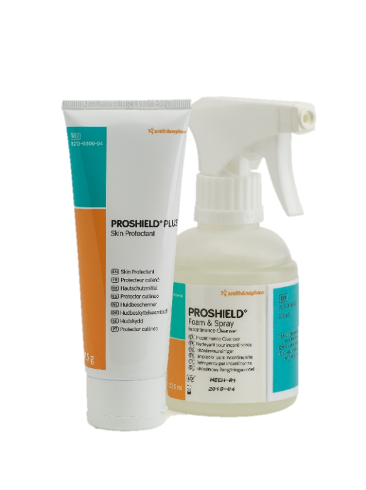References
Beeckman D, Campbell J, Campbell K, et al (2015) Proceedings of the Global IAD expert panel. Incontinence Associated Dermatitis: moving prevention forward. Wounds International, London. Available online www.woundsinternational.com
Beeckman D, Van Damme N, Schoonhoven L, et al (2016) Interventions for preventing and treating incontinence-associated dermatitis in adults. Cochrane Database of Systematic Reviews, Issue 11. Art. No.: CD011627. DOI: 10.1002/14651858.CD011627.pub2
Beeckman D (2017) A decade of research on incontinence-associated dermatitis: Evidence, knowledge gaps and next steps. J Tissue Viability 26(1): 47–56
Flanagan M (2020) Incontinence-associated dermatitis 2: assessment, diagnosis and management. Nurs Times [online] 116(4): 40-44
Flynn D, Williams S (2011) Barrier creams for skin breakdown. Nurs Residential Care 13(11): 553–8
Hoggarth A, Waring M, Alexander J, Greenwood A, Callaghan T (2005) A Controlled, Three-Part Trial to Investigate the Barrier Function and Skin Hydration Properties of Six Skin Protectants. Ostomy Wound Manage 51(12): 30-42
Howers L, Boyett F (2012) Evaluation of Proshield Plus in nursing homes for inclusion onto formulary in a healthcare trust. Wounds UK poster presentation. Harrogate, UK
Ling L (2011) Proshield skin care protective system: A sequence of evaluations. Wounds UK poster presentation. Harrogate, UK
Maxwell J, Sinclair D (2012) Treatment of Moisture Lesions in Children. Paper presented at: European Wound Management Association; Vienna, Austria
Meuleneire F (2010) A new solution in the treatment of moisture lesions. European Pressure Ulcer Advisory Panel (EPUAP) poster presentation. Birmingham, UK: 1-3 September
NHS England (2018) Excellence in continence care: Practical guidance for commissioners, and leaders in health and social care. Available online: https://www.england.nhs.uk/wp-content/uploads/2018/07/excellence-in-continence-care.pdf
Ousey K, O’Connor L (2017) Incontinence Associated Dermatitis Made Easy. Wounds UK 13(1): 1–6
Penzer R, et al (2012) Best practice in emollient therapy. A statement for healthcare professionals. Dermatological Nurs 11(4): S1-S19
Shah S, Cornell M, Ward AJ (1995) Evaluation of moisture through skin protectant barriers by paper chromatography. Adv Skin Wound Care 8(4): 20–27
Smith & Nephew (2019a) Review of Certificate of Analysis for Proshield Foam & Spray Incontinence Cleanser. RD/19/024
Smith and Nephew (2019b) Verification Testing Report of Usability and Transparency for PROSHIELD PLUS Skin Protectant. U/064/R3
Smith & Nephew (2019c) Verification Testing Report of Usability and Transparency for PROSHIELD Plus Skin Protectant. U/064/R1
Smith & Nephew (2019d) Review of Certificate of Analysis for PROSHIELD Plus Skin Protectant. RD.19.016
Wall L, Vernon T (2016) Launch of a skin care regime to reduce the incidence of moisture associated skin damage. Poster presentation, Tissue Viability Society (TVS) conference, UK
Woo K, Beeckman D, Chakravarthy D (2017) Management of moisture-associated skin damage: A scoping review. Adv Skin Wound Care 30(11): 494-501
Beeckman D, Van Damme N, Schoonhoven L, et al (2016) Interventions for preventing and treating incontinence-associated dermatitis in adults. Cochrane Database of Systematic Reviews, Issue 11. Art. No.: CD011627. DOI: 10.1002/14651858.CD011627.pub2
Beeckman D (2017) A decade of research on incontinence-associated dermatitis: Evidence, knowledge gaps and next steps. J Tissue Viability 26(1): 47–56
Flanagan M (2020) Incontinence-associated dermatitis 2: assessment, diagnosis and management. Nurs Times [online] 116(4): 40-44
Flynn D, Williams S (2011) Barrier creams for skin breakdown. Nurs Residential Care 13(11): 553–8
Hoggarth A, Waring M, Alexander J, Greenwood A, Callaghan T (2005) A Controlled, Three-Part Trial to Investigate the Barrier Function and Skin Hydration Properties of Six Skin Protectants. Ostomy Wound Manage 51(12): 30-42
Howers L, Boyett F (2012) Evaluation of Proshield Plus in nursing homes for inclusion onto formulary in a healthcare trust. Wounds UK poster presentation. Harrogate, UK
Ling L (2011) Proshield skin care protective system: A sequence of evaluations. Wounds UK poster presentation. Harrogate, UK
Maxwell J, Sinclair D (2012) Treatment of Moisture Lesions in Children. Paper presented at: European Wound Management Association; Vienna, Austria
Meuleneire F (2010) A new solution in the treatment of moisture lesions. European Pressure Ulcer Advisory Panel (EPUAP) poster presentation. Birmingham, UK: 1-3 September
NHS England (2018) Excellence in continence care: Practical guidance for commissioners, and leaders in health and social care. Available online: https://www.england.nhs.uk/wp-content/uploads/2018/07/excellence-in-continence-care.pdf
Ousey K, O’Connor L (2017) Incontinence Associated Dermatitis Made Easy. Wounds UK 13(1): 1–6
Penzer R, et al (2012) Best practice in emollient therapy. A statement for healthcare professionals. Dermatological Nurs 11(4): S1-S19
Shah S, Cornell M, Ward AJ (1995) Evaluation of moisture through skin protectant barriers by paper chromatography. Adv Skin Wound Care 8(4): 20–27
Smith & Nephew (2019a) Review of Certificate of Analysis for Proshield Foam & Spray Incontinence Cleanser. RD/19/024
Smith and Nephew (2019b) Verification Testing Report of Usability and Transparency for PROSHIELD PLUS Skin Protectant. U/064/R3
Smith & Nephew (2019c) Verification Testing Report of Usability and Transparency for PROSHIELD Plus Skin Protectant. U/064/R1
Smith & Nephew (2019d) Review of Certificate of Analysis for PROSHIELD Plus Skin Protectant. RD.19.016
Wall L, Vernon T (2016) Launch of a skin care regime to reduce the incidence of moisture associated skin damage. Poster presentation, Tissue Viability Society (TVS) conference, UK
Woo K, Beeckman D, Chakravarthy D (2017) Management of moisture-associated skin damage: A scoping review. Adv Skin Wound Care 30(11): 494-501



